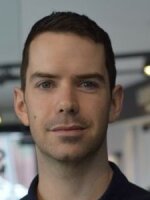When Zach Huelsing and Jon Lehman started dating long-distance in 2007, the lonely drives on the highway to see each other soon became tedious.
So they began taking the side roads, winding their way between Chicago and downstate Illinois, and taking photos from blink-and-you-miss-them towns.
"Just to show what we had seen on these journeys," Jon says.
Within a few years, they had amassed a decent trove of images focused on the buildings, signs and symbols in the towns they passed through, and they decided to start a catalog. And so, the Rural Indexing Project was created.
Fast forward another decade, and the pastime-turned-passion has grown to now include more than 50,000 photos from nearly 1,500 municipalities in 28 states.


"We'd spend 10-11 hours in the car, all day long, and travel from town to town. And I guess we started to see patterns develop," Jon says.
Those patterns are a central part of the Rural Indexing Project.
Because when they upload each photo to the catalog, they don't just list it as "grocery store, North Dakota" — they assign keywords like the materials used, the institution type, the architectural elements, and words on buildings. Basically, any kind of social marker they find relevant.
That meticulous indexing allows them to then compare images over time and location; like how a post office looks in, say, Douglas, Nebraska versus Ophir, Colorado.

It's also allowed them to bust a few myths and maybe even their own misconceptions about modern rural America.
"It's been interesting to have been working on this project over the course of ... so many politically divergent presidential administrations, for instance," Jon said. "We started out in the Obama years, sort of with the idea that, was this going to be rural America's last hurrah? And that's clearly not proven to be the case."
Still, the data does show rural America is slowly shrinking. Folks are leaving small towns, and cities are expanding with new homes and shops to accommodate surging populations.
In the face of this, Jon and Zach's project has picked up on a trend: there aren't many new buildings in the smallest towns. Instead, the old ones find a new purpose.

Take Rob's Locker and Catering in Gary, South Dakota — population 297 (give or take). This, in Jon's estimation, is a sign of something that rural America can teach the cities.
"So many of the images that are propagated from rural parts of the country focus on decay or on destruction or abandonment, and we're very interested in the ways that buildings, in particular, continue to serve and continue to be adapted in ways that meet the needs of communities," he said.
"I think we can actually learn some lessons ... the stories that our photographs tell are stories of adaptive reuse."

It's no accident they find these themes fascinating. Zach trained as an architect and has a background in anthropology. Jon has a background in urban planning.
They pause at the suggestion their photos could be interpreted as nostalgic. That's not their intention, and they are not in the business of myth-making.
Instead, they go to lengths to present a neutral image, waiting for pedestrians and cars to leave the frame and taking the photos front-on and eye level. This is an exercise in documentation, rather than an artistic endeavor.


Jon and Zach say they've had to explain themselves to some skeptical locals over the years, but for the most part they have been welcomed.
"People are protective about their communities and wonder who these strangers are who rolled into the town, and are showing interest in their community," Zach said. "Because I think that is a little abnormal these days, to be honest with you."
"There is that skepticism ... but then most people, once we explain what we're doing, they're interested or they actually want to tell us about historical sites that they know nearby."

As the project grows, Jon and Zach are becoming increasingly preoccupied with another thought. Zach struggles for a moment to attach an emotion to it, but eventually settles on "unease."
"We consider this project to be on stolen land," Zach says. "The vast territory we have been documenting was until recently solely inhabited by native peoples who became victims of forced relocation and genocide, allowing the settlements we photograph to be erected.'
"It's fascinating to document how architectural and cultural trends are deployed across the country, but we've seen that widespread disinvestment — as well as patterns of renovation and repurposing — add to an already palpable sense of impermanence."
What the future of these towns looks like, then, is a looming question. But as the Rural Indexing Project expands, it's one that Zach and Jon may be uniquely placed to answer.
You can follow the Rural Indexing Project on its website, on Twitter and on Instagram.
Copyright 2023 NPR. To see more, visit https://www.npr.org.








